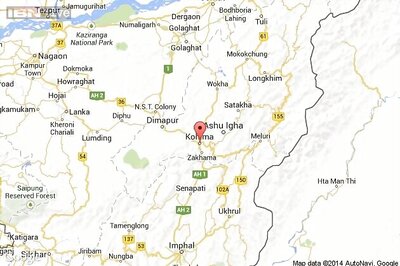
views
New Delhi: The tensions between India and Pakistan have de-escalated with the return of Wing Commander Abhinandan Varthaman. Expectedly, India will wait for Pakistan’s response on the dossier it has handed over to the latter on “specific details” of involvement of the JeM in the Pulwama terror attack on the CRPF as also the presence of camps of the UN-proscribed terror outfit in that country.
It all started with the February 14 Pulwama attack, which resulted in the death of more than 40 CRPF personnel. Two weeks later, India retaliated with air strikes on February 26 in which the government said it had destroyed Jaish-e-Mohammed (JeM) terror camps in Balakot, Pakistan. The air strikes were followed by an aerial standoff between India and Pakistan the following day, resulting in the downing of an Indian Air Force (IAF) MiG-21 Bison chopper — which crashed in Pakistan Occupied Kashmir (PoK) — and the capture of Varthaman.
While India conducted an air strike for the first time since 1971, some past instances indicate that several nations opt for such strikes during escalations. In 1982, Israel destroyed 19 surface-to-air missile batteries in the Lebanon territory. In 2015, the Egyptian Air Force attacked the Islamic State of Iraq and the Levant (ISIL) training camps, and weapon stockpiles in Libya in retaliation to a video ISIL released of the beheading of 21 Coptic Christians from Egypt.
How India, Pakistan Fare
India has over 1,27,200 personnel and 60 air bases while Pakistan has a strength of about 78,000 combatants and 21 air stations. India has more advanced combat aircrafts than Pakistan. The IAF’s most advanced fighter jet in operation, Sukhoi Su-30MKI, is the primary air-to-air and air-to-ground strike machine. Also known as Flanker, it is made in India by HAL under licence agreement with Russia’s Sukhoi and is being exclusively used by India.
Inducted in 2002, the IAF has about 250 operational units of 30MKIs till now. The Sukhoi Su-30MKI has a top speed of Mach 2 (2,120 kmph) and a maximum take-off weight of 38,800 kg. The jet can carry a wide range of equipment from radars to missiles, bombs and even rockets.
Commissioned in 1985, the Mirage-2000 or Vajra (thunderbolt in Sanskrit) has been IAF’s deadliest aircraft. Taking into account its successful stint in the Kargil War, India in 2004 increased its tally from 40 to 50. Mirage-2000 was extensively escorted by MiG-29 in the war attacking targets with laser-guided bombs.
Another fighter jet, SEPECAT Jaguar or Shamsher, was developed jointly by British Royal Air Force (RAF) and French Air Force. Only the IAF is currently using the upgraded Jaguar, which at present number 91, in active duty. It serves the IAF as primary ground attack aircraft. Built locally by HAL under a licence agreement, the Indian Jaguars are quite different from the RAF’s Jaguar. The IAF recently upgraded its entire fleet of Jaguars by adding Avionics support. The Jaguar, however, is unable to fly at high altitude with a heavy load on board.
Introduced in the 1970s to counter F-Series planes of the United States such as F-15 and F-16, the Soviet-made MiG-29 or Baaz forms the second line of defence after the Sukhoi Su-30MKI. It is exported to over 30 nations, with India being the first and one of the largest exporters. The IAF currently uses the upgraded and the most advanced variant, MiG-29 UPG.
The made-in-India Tejas Light Combat Aircraft (LCA) is replacing the ageing Soviet sourced MiG-21. Among the 40 of them ordered by India till now, 32 are single-seaters and eight twin-seat trainers. The IAF has also initiated procurement of another 73 single-seat fighters in Mk 1A configuration.
The Hercules C-130J, the all-weather transport aircraft, was instrumental in the operations at the Air Force Station in Pathankot and deployment of paramilitary troops in Srinagar. The IAF has inducted additional six C-130J aircraft in 2017 and its operational capability is being enhanced by procuring night vision goggles.
The Mikoyan MiG-21 is the first supersonic jet aircraft in aviation history. Since 1961, India has bought over 250 units of these planes relying on their consistency and competency. They currently serve as interceptors with limited role as fighter jets. The MiG 21 has a single-seater cockpit with the maximum speed of 1.05 mach (1300 kmph) and it played a crucial role in the 1971 Indo-Pak War.
The Indian fleet also includes 85 MiG 27 or Bahadur (valiant) which are gradually being phased out to acknowledge service issues, while 40 of them have been upgraded.
On the contrary, Pakistan has Dassault-made Mirage 5, Mirage III, Chengdu J7, JF-17 and F16s. Mirage 5 is derived from Mirage III, the single-seat and single-engine fighter aircraft being used as interceptors. The Chengdu F-7PG is another fighter jet with upgraded radar system with effective targeting skills. Despite being the largest non-Chinese user with about 120 F-7P and about 60 F-7PG, Pakistan is going to replace them with JF-17 Thunder multirole fighters.
While the J7 is a lower-end combatant, the JF-17s are light-weight, single-engine, multirole combat fighters developed jointly by Pakistan and China. The joint fighters (JF) are capable of all-weather operations against both air and surface targets. Their aerodynamics is comparable to the Indian Tejas and they can be used for aerial inspection, ground attacks and aircraft interception. The jet with a top-speed of 1.8 Mach (2222.64 kmph) was a replacement of all other lower-end combatants such as the Q5, Mirage III/V and J7. The later units are likely to be armed with advanced sensors, weapons and defensive systems.
And then there are the US-made F16 Fighting Falcons, the most superior fleet Pakistan has. Operationally, the PAF have used it during the Soviet-Afghan war. It has also been used to attack militant positions against the Taliban insurgency in North-West Pakistan. The F16’s potent to orient AIM-120 Advanced Medium-Range Air-to-Air Missile (AMRAAM) provides the PAF the capability of formidable, beyond visual range air combat. As per a Carnegie report of 2018, the acquisition of Chinese J-31s is in progress.
As the IAF waits for Rafale jets, the MiG series are already over 50 years old. While they are scheduled to phase out by 2022, the recent stand-off led to experts questioning the approval to MiGs in the conflict against Pakistan’s F16, underscoring the former being a better-resourced air power.
The Chinese Spell
Pakistan also has the benefit of immense support it gets from another principal adversary of India, China.
“China and Pakistan field about 740 advanced air defence/multirole fighters against the IAF’s 450-odd equivalents,” says a Carnegie report. “China and Pakistan make concerted efforts to resolve their own airpower problems in ways that will make them dangerous challengers of the sort unimaginable barely a decade ago,” the report adds.
It further states that with talks with China and US, the PAF could soon operate some 40 J-31 stealth fighters at the high-end, 100 F-16s armed with the best beyond-visual-range air-to-air missiles and other advanced air-to-ground munitions, some J-10s and 250 JF-17s at the low end. “The aircraft in all three classes would be capable of undertaking both air-to-air and air-to-ground operations as required,” the report states.
The Chinese People’s Liberation Army Air Force (PLAAF) is likely to sport about 800 advanced fighters by 2020 with the PAF fielding about 200 modern aircraft. Noting the possibility, the IAF has said it needs 60 combat squadrons to deal with “the challenges posed by the serious two-front threat”.
However, the IAF has the strength of only 36.5 operable squadrons against the already inadequate sanctioned 39.5 squadrons, from which it can barely muster 32 squadrons of fighters.
When asked why India chose to battle in the air in the recent escalation with Pakistan, ex-Air Chief Marshal Fali Homi Major told News18.com: “Why they used it is a very difficult question to answer because a lot of issues are factored in before an option is used. So, it was according to the wisdom of the government.”
Rahul Bedi, a veteran defence journalist, explained: “The IAF was deployed because the land option had already been exercised in September 2016 and the naval option was not really under consideration for a variety of logistical and equipment-related reasons. So, the air force really was the only option left to the government and the military planners because there is a stand-off capability that the Air Force has of attacking targets from a distance. Also, it has the element of swiftness and surprise.”




















Comments
0 comment